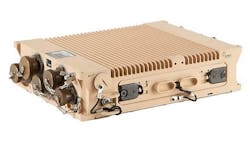Marine Corps orders 1U rugged computer servers for the battlefield from Leonardo DRS
Officials of the Marine Corps Systems Command in Quantico, Va., have announced an $11.4 million order to DRS for 1,203 1U servers for Marine Corps Data Distribution System – Modular (DDS-M).
The DDS-M is part of the Marine Corps's Tactical Networking Systems family of baseband networking hardware and software that provide services for MAGTF tactical communications networks. Marine Corps Tactical Networking Systems comprises the Tactical Data Network (TDN) Data Distribution System-Modular (DDS-M) core, and expansion modules; the digital technical control (DTC); and the tactical voice switching system (TVSS).
The DDS-M provides Marine Corps warfighters with a ‘take what the mission needs’ capability, and provides an integrated data network to the MAGTF commander.
Related: DRS Tactical Systems to provide rugged in-vehicle computers in $455 million contract
DRS designs and manufactures the Data Distribution Unit - Expandable (DDUx) and the Mounted Family of Computer Systems (MFoCS) processor unit (PU) for rugged battlefield computing needs.
The DDUx server can be used standalone with rugged display attached, or with rugged tablet. It uses the Intel Core i7 processor, removable 2.5-inch solid-state hard drives, and external interfaces. The battlefield server can perform general-purpose computing, interface sensors and networks, and perform video processing.
The DDUx can operate several operating systems and virtual machines at once. Users can customize the DDUx with a capability upgrade bay that can provide additional Ethernet ports, 802.11 wireless, and similar capabilities.
The DDUx has a trusted platform module (TPM) as part of its embedded security architecture based on advanced trusted computing technologies for cyber security. It offers a secure BIOS architecture, per-computer unique BIOS password assignment, digitally signed BIOS updates, factory provisioned TPM, Measured launch environment, and secure storage of customer preplaced keys.
Related: DRS to provide vetronics rugged computers for Army FBCB2 program in $61.6 million contract
The MFoCS processor unit, meanwhile, offers the Intel Core i7 quad core processor at 3.1 GHz, with as much as 16 gigabytes of DDR3 ECC RAM, and two internal hard drive bays.
The Marine Corps DDS-M can authenticate users and equipment, send and receive electronic mail, share and store files, perform information assurance, and route digital messages between the local area network, circuit switch, and tactical wideband networking radio subnetworks.
On this contract, which the Marine Corps awarded on 29 Sept. 2017, DRS will do the work in Lebanon, Tenn., and should be finished by November 2017. For more information contact Leonardo DRS Network & Imaging Systems online at www.leonardodrs.com/locations/drs-network-imaging-systems-llc-melbourne-fl, or Marine Corps Systems Command at www.marcorsyscom.marines.mil.
Ready to make a purchase? Search the Military & Aerospace Electronics Buyer's Guide for companies, new products, press releases, and videos
